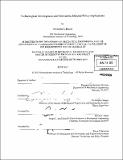| dc.contributor.advisor | Christopher Magee. | en_US |
| dc.contributor.author | Benson, Christopher Lee | en_US |
| dc.contributor.other | Massachusetts Institute of Technology. Technology and Policy Program. | en_US |
| dc.date.accessioned | 2012-10-26T18:10:05Z | |
| dc.date.available | 2012-10-26T18:10:05Z | |
| dc.date.copyright | 2012 | en_US |
| dc.date.issued | 2012 | en_US |
| dc.identifier.uri | http://hdl.handle.net/1721.1/74453 | |
| dc.description | Thesis (S.M.)--Massachusetts Institute of Technology, Dept. of Mechanical Engineering; and, (S.M. in Technology and Policy)--Massachusetts Institute of Technology, Engineering Systems Division, Technology and Policy Program, 2012. | en_US |
| dc.description | Cataloged from PDF version of thesis. | en_US |
| dc.description | Includes bibliographical references (p. 59-62). | en_US |
| dc.description.abstract | Technological development is one of the main drivers in economic progress throughout the world and is strongly linked to the creation of new industries, jobs, and wealth. This thesis attempts to better understand how a specific technological field develops over time and to examine the policy implications resulting from that research. In order to research the specific field, we present a repeatable method to identify and describe the important innovations in an industry, using the solar photovoltaic industry as a case study. A set of 2484 patented inventions in the solar PV industry between 1961 and 2011 was selected and their metadata and textual information were analyzed using a mixture of qualitative, quantitative and objective tests. Within the patent set, a group of most highly cited patents was located and defined. We found that these highly cited patents improved on technologies across different technological hierarchy levels and that the hierarchy levels did not appear to follow any pattern over time. When compared with other patents in the set of 2484, the highly cited patents, contrary to some conjectures, did not apparently rely more on new scientific discoveries as they did not cite scientific literature more frequently than less cited patents. These findings support the theory that even the most important developments in a field are part of an integrated system and cannot be treated as standalone improvements. The work also indicates that ascribing the bulk of progress to "breakthroughs" is not seen in objective data. The thesis continues with an analysis of how these findings may apply to innovation polices in organizations. Finally, technological innovation strategies within MIT, Stanford and the United States Air Force are analyzed through the lens of the model constructed from the findings. | en_US |
| dc.description.statementofresponsibility | by Christopher L Benson. | en_US |
| dc.format.extent | 62 p. | en_US |
| dc.language.iso | eng | en_US |
| dc.publisher | Massachusetts Institute of Technology | en_US |
| dc.rights | M.I.T. theses are protected by
copyright. They may be viewed from this source for any purpose, but
reproduction or distribution in any format is prohibited without written
permission. See provided URL for inquiries about permission. | en_US |
| dc.rights.uri | http://dspace.mit.edu/handle/1721.1/7582 | en_US |
| dc.subject | Mechanical Engineering. | en_US |
| dc.subject | Engineering Systems Division. | en_US |
| dc.subject | Technology and Policy Program. | en_US |
| dc.title | Technological development and innovation : selected policy implications | en_US |
| dc.type | Thesis | en_US |
| dc.description.degree | S.M.in Technology and Policy | en_US |
| dc.description.degree | S.M. | en_US |
| dc.contributor.department | Massachusetts Institute of Technology. Department of Mechanical Engineering | |
| dc.contributor.department | Massachusetts Institute of Technology. Engineering Systems Division | |
| dc.contributor.department | Technology and Policy Program | |
| dc.identifier.oclc | 813318557 | en_US |
